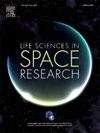Thoracolumbar spine muscle size and composition changes in long-duration space missions
IF 2.8
3区 生物学
Q2 ASTRONOMY & ASTROPHYSICS
引用次数: 0
Abstract
Muscle atrophy occurs with extended exposure to microgravity. This study quantified the overall muscle size, lean muscle area and fat infiltration changes pre- to post-flight that occur in the thoracic and lumbar spine with long-duration spaceflight. Pre- and post-flight magnetic resonance imaging (MRI) scans were obtained from 9 crewmembers on long-duration (≥6 months) International Space Station (ISS) missions. Muscle size was measured by the cross-sectional area (CSA) and lean muscle tissue by the functional cross-sectional area (FCSA). Muscle-fat infiltration (MFI) was measured by the mean pixel intensities of the MRI in fat and water phases. A mixed model with random subject effect was used to analyze pre- to post-flight changes. Significant decreases were seen in the quadratus lumborum muscle size (-1.8 ± 0.6% per month, p = 0.002) and lean muscle tissue content in the paraspinal muscles (-0.7 ± 0.2% per month, p ≤ 0.001). Fat infiltration increased significantly in the transversospinalis (+4.1 ± 1.0% per month, p ≤ 0.01) muscle. Treadmill exercise had a tendency to reduce fat content in the paraspinal and quadratus lumborum muscles, while counteracting muscle build-up only in the paraspinal muscles. Cycle ergometer exercise suggested benefits for the psoas muscle. Resistance training appeared to benefit lean muscle mass of most thoracolumbar muscles. Our findings highlight the need for countermeasures to prevent muscle atrophy and detrimental effects in muscle composition during long-duration spaceflight.
长期太空任务中胸腰椎肌肉大小和组成的变化
长时间暴露在微重力环境中会导致肌肉萎缩。本研究对长时间太空飞行时胸椎和腰椎的整体肌肉大小、瘦肌肉面积和脂肪浸润在飞行前和飞行后的变化进行了量化。研究人员采集了 9 名执行长期(≥6 个月)国际空间站(ISS)任务的乘员飞行前和飞行后的磁共振成像(MRI)扫描结果。肌肉大小通过横截面积(CSA)测量,瘦肌肉组织通过功能横截面积(FCSA)测量。肌肉脂肪浸润(MFI)通过核磁共振成像在脂肪和水相的平均像素强度进行测量。采用随机受试者效应混合模型分析飞行前和飞行后的变化。结果显示,腰方肌大小(每月-1.8 ± 0.6%,p = 0.002)和脊柱旁肌肉中的瘦肌肉组织含量(每月-0.7 ± 0.2%,p ≤ 0.001)均显著下降。横隔肌的脂肪浸润明显增加(每月 +4.1 ± 1.0%,p ≤ 0.01)。跑步机运动倾向于减少脊柱旁肌和腰四头肌的脂肪含量,而只抵消脊柱旁肌的肌肉堆积。自行车测力计运动对腰肌有好处。阻力训练似乎有益于大多数胸腰部肌肉的瘦肌肉质量。我们的研究结果突出表明,在长期太空飞行期间,需要采取对策防止肌肉萎缩和肌肉成分的不利影响。
本文章由计算机程序翻译,如有差异,请以英文原文为准。
求助全文
约1分钟内获得全文
求助全文
来源期刊

Life Sciences in Space Research
Agricultural and Biological Sciences-Agricultural and Biological Sciences (miscellaneous)
CiteScore
5.30
自引率
8.00%
发文量
69
期刊介绍:
Life Sciences in Space Research publishes high quality original research and review articles in areas previously covered by the Life Sciences section of COSPAR''s other society journal Advances in Space Research.
Life Sciences in Space Research features an editorial team of top scientists in the space radiation field and guarantees a fast turnaround time from submission to editorial decision.
 求助内容:
求助内容: 应助结果提醒方式:
应助结果提醒方式:


